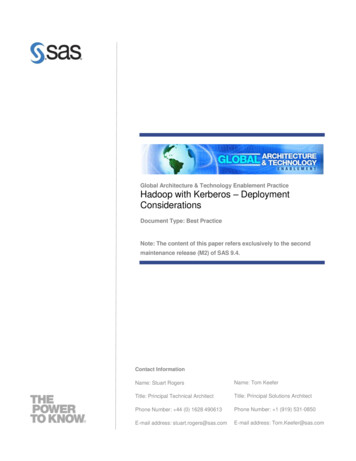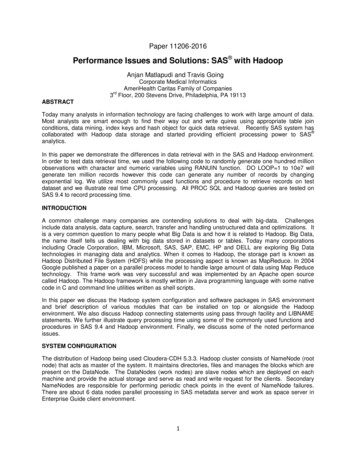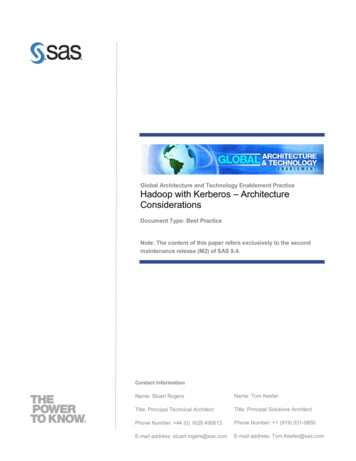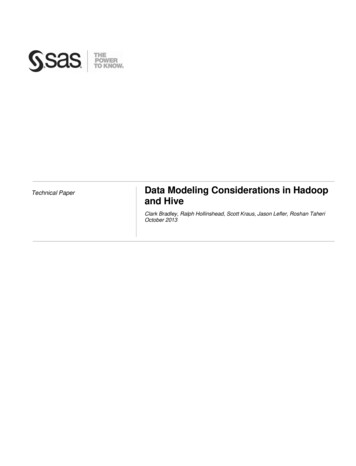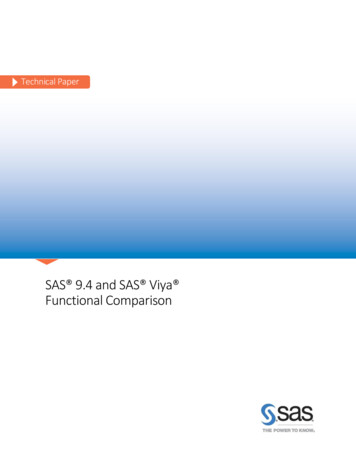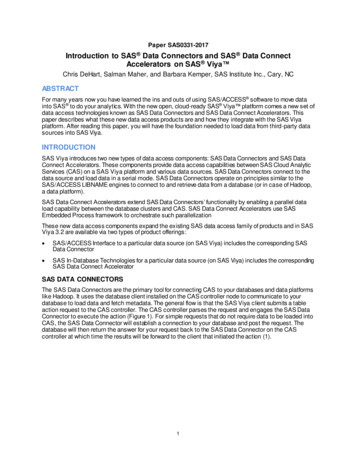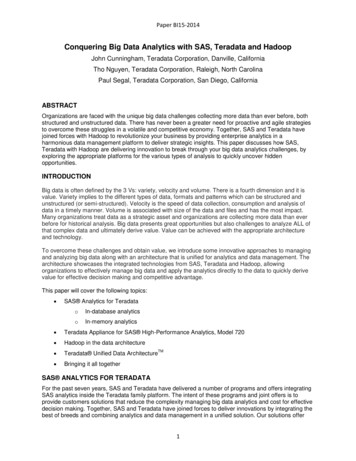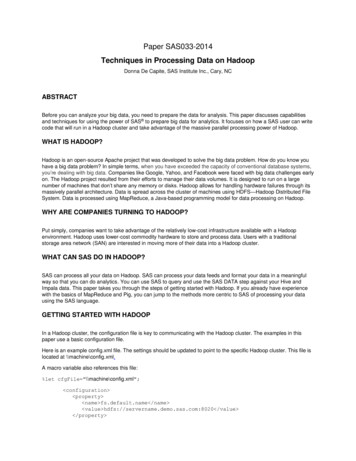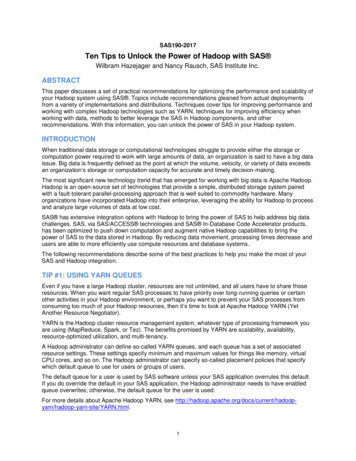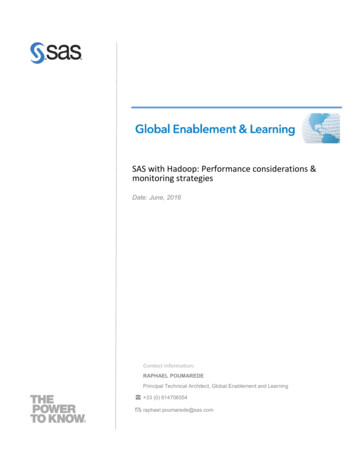
Transcription
SAS with Hadoop: Performance considerations &monitoring strategiesDate: June, 2016Contact Information:RAPHAEL POUMAREDEPrincipal Technical Architect, Global Enablement and Learning 33 (0) 614706554 raphael.poumarede@sas.com
Table of Contents0Introduction and setting expectations . 11Data Management (SAS/ACCESS) . 41.1Push data management down to Hadoop! . 41.2Optimize your SELECT . 61.3The “Order by” hurdle . 81.4Create a Hive table from SAS (CTAS) . 121.5MapReduce or Tez? . 141.6File formats and partitioning . 161.7Other tricks . 202In-Hadoop processing . 232.1Introduction . 232.2Push processing down to Hadoop! . 252.3File formats & partitioning. 302.4Resource management & Hadoop tuning . 303Lessons learned . 323.1SAS on Hadoop general lessons learned . 323.2SAS jobs adaptation lessons learned . 323.3Make your SAS jobs ready for Hadoop . 333.4Project use case . 344Monitoring SAS in Hadoop . 374.1Increase SAS verbosity . 374.2Monitor SAS jobs and storage in Hadoop. 424.3Other monitoring tools (Ambari, CM, Hue) . 484.4Monitor ZooKeeper connections . 60
5Appendix . 615.1Limitations of the testing environment used here . 615.2Hadoop file type benchmark . 625.3References . 63
1 of 68SASWITHHADOOPPERFORMANCES CONSIDERATIONS0 Introduction and setting expectationsThis document is not an exhaustive guide on all possible optimizations, but rather a collection of tricks andbest practice reminders coming from the field experience. It might help the consultant on the ground whenperformance issues arise in a SAS with Hadoop environment.A very general recommendation for performances, when SAS interacts with an external data store is to avoidthe download of remote data on the SAS machine and to use in-database processing instead. Using SAS indatabase processing, you can run scoring models, some SAS procedures, DS2 thread programs, and formattedSQL queries inside the data source.This same recommendation is even more important in the Hadoop world, as data stored in Hadoop can bemassive. Source and target tables can be in terabytes and petabytes, and only a hundreds- or thousands-coreHadoop distributed platform will be able to crunch the data in acceptable time. It will not even be possible tobring back data of this size across internal networks.So our main goal will be to push down most of the data processing to Hadoop. We will talk about in-Hadoopprocessing.The table below is based on the Introduction to SAS In-Database Processing and presents the currentavailable in-Hadoop features and the requirements in terms of software.
2 of 68SASWITHHADOOPPERFORMANCES CONSIDERATIONSIn-Hadoop featureScoring modelsSoftware RequiredBase SAS SAS/ACCESS Interface to the data sourceSAS Scoring AcceleratorSAS Enterprise Miner SAS Factory Miner (analytic store scoring)SAS Scalable Performance Data Server (optional)SAS Model Manager (optional)Base SAS procedures:FREQREPORTSUMMARY/MEANSTABULATEBase SASSAS/ACCESS Interface to the data sourceBase SAS procedures:TRANSPOSE (preproduction)Base SASSAS/ACCESS Interface to the data sourceSAS In-Database Code Accelerator (SAS Data Loaderfor Hadoop)Base SASSAS/ACCESS Interface to the data sourceSAS In-Database Code Accelerator (SAS Data Loaderfor Hadoop)Base SASSAS/ACCESS Interface to HadoopDS2 threaded programs (across Hadoop nodes)DATA step scoring programsData quality operationsBase SASSAS/ACCESS Interface to HadoopSAS In-Database Code AcceleratorSAS Data Loader for HadoopExtract and transform dataBase SASSAS/ACCESS Interface to HadoopSAS Data Loader for HadoopAs SAS software and Hadoop are constantly being developed, the reader should always check the currentdocumentation to confirm what the supported features are as the list is likely to change over time.The following page is maintained with current supported Hadoop versions for the various SAS tysupport/v94/hadoop/hadoop-distributions.htmlThe SAS Embedded Process is the core component used by products such as SAS Scoring Accelerator, SASIn-Database Code Accelerator, and SAS Data Quality Accelerator to enable SAS advanced analyticsprocessing inside Hadoop. It will also be used for specific use cases like asymmetric HPA processing, SASLASR Analytic Server parallel lift from Hadoop, and so on.
3 of 68SASWITHHADOOPPERFORMANCES CONSIDERATIONSHowever, if you don’t have the SAS Embedded Process in your deployment, by using the best practices andoptimization techniques, you can make sure your data management operations (PROC SQL, basic procedures,or the SAS DATA step) will be successfully converted by the SAS/ACCESS engine to run inside Hadoop.The first section of the document will focus on SAS/ACCESS best practices and tips. This is aimed atmaximizing the data management operations to be completed by the Hadoop cluster. The Hadoop processingframework was designed to leverage distributed processing across the Hadoop nodes from the outset.In the second section, we will assume that the SAS Embedded Process has been deployed inside the Hadoopcluster, and we will focus on the way to leverage it to run SAS analytics operations directly in-Hadoop.In the third section, lessons learned from several field experiences and feedback are shared. Manyrecommendations from this document are coming from these experiences and feedback.Finally the last section will give the main options and tools to monitor (and eventually troubleshoot) SASanalytics processing in Hadoop.Note: This version of the document does not cover:-SAS High Performance AnalyticsSAS/ACCESS to ImpalaSAS Scoring AcceleratorSAS Data Quality Accelerator
4 of 68SASWITHHADOOPPERFORMANCES CONSIDERATIONS1 Data Management (SAS/ACCESS)1.1 Push data management down to Hadoop!1.1.1 Implicit and explicit SQL pass-throughIn SAS code you have two ways to interact with an external Database: implicit and explicit pass-through.When you use a SAS LIBNAME statement in a DATA step or PROC SQL, it is implicit SQL pass-throughand SAS will to convert your SAS code to an SQL code that the target DBMS can process. The SAS/ACCESSengine will attempt to delegate most of the processing work to the Database in order to avoid a SELECT *order.On the other hand, explicit SQL pass-through is a coding syntax that allows the user to write/submit databasespecific SQL that SAS will pass untouched to that database.The SAS user, usually prefers to work with implicit SQL pass-through as it is easier to write, does not requireskills in the specific DBMS SQL syntax, and is also generally the resulting code of GUI wizards or solutions.Nevertheless, depending on the functions used or the way the code is written, the conversion is not alwayspossible for the SAS/ACCESS engine, in which case the data is downloaded from the remote DBMS on theSAS server for local processing using SAS data sets.In the real world, Hadoop clusters can be really big in terms of resources and tables sizes. Customers can have100 to over 1,000 nodes in their Hadoop environments. In these environments due to the size of data, meaningthat the source and target tables are in the hundreds of gigabytes if not terabytes, it is not possible to bring thedata back to SAS to run the query efficiently.As pointed out in the next section (Best practices), there are techniques to increase the ability of the SAS SQLplanner to interpret SQL code and to allow the implicit SQL pass-through to be as efficient as explicit SQLpass-through.1.1.2 Best practicesGeneral guidelines when you develop and run SAS data operations with Hadoop are listed here: Push down the SQL processing to Hive as much as possible:
5 of 68SASWITHHADOOPPERFORMANCES CONSIDERATIONSoAvoid merging SAS data with Hive data. It is recommended that you transform the SASdata set in a Hive table and run the merge inside Hive to leverage distributed processing andavoid network traffic between SAS workspace server node and the Hadoop cluster. SeePassing joins to Hadoop.oAvoid using a function that will bring Hadoop data back to the SAS server, See Passing SASfunctions to Hadoop.oUse the SASTRACE option to display details of the communications between SAS andHadoop.oCompare with SQL explicit pass-through.oUse the “magic options” (see below) to help the SQL planner to push down processing inHadoop. Monitor end-to-end progress of a job to identify under-optimized queries. Identify the bottleneck in the chain. When a data operation from SAS is longer than expected, try totranslate it in HIVEQL and to run it directly in the server. If the times are similar, Hive optimizationmight be required.1.1.3 Magic options-Use DBIDIRECTEXEC when using CREATE TABLE AS SELECT (CTAS) operations. (SeeCreate a Hive table from SAS (CTAS).)-Use SQL FUNCTIONS ALL, which allows for SAS functions that have slightly different behaviorfrom corresponding Hadoop functions that are passed down to Hadoop. (See Passing SAS Functionsto Hadoop.)
6 of 68SASWITHHADOOPPERFORMANCES CONSIDERATIONS1.2 Optimize your SELECT1.2.1 Fetch task instead of MapReduce applicationNearly every time SAS interacts with a Hive table (for example, to display the table attribute from SAS Enterprise Guide or SAS Enterprise Miner graphical assistants), it performs SELECT * to Hive, whichwill run a MapReduce lob to download the full table.Additionally, each time you use the PROC SQL with a HADOOP LIBNAME table (implicit SQL passthrough), a preliminary SELECT * order is always sent, triggering a MapReduce job.It is not a problem if you have a small table, but as soon as you start dealing with million-row tables (not evenreally big data) it can take several minutes to perform the above operations.There is a solution. You can force Hive to use a fetch task to perform this initial query.With a fetch task, Hive directly goes to the file and gives the result, rather than start a MapReduce job for theincoming query. For simple queries like SELECT * with limit, it is much faster. In this case, Hive will returnthe results by performing an HDFS operation (hadoop fs –get equivalent).Of course it will not be efficient for all type of queries. But when the Hive property hive.fetch.task.conversionis set to minimal, the Hive engine will use the fetch action only for specific light queries where it makes sense(like our automatic SELECT * to get the table’s metadata) and will generate MapReduce jobs for other typesof queries (where the fetch is not efficient).Finally, there is also another parameter related to this: hive.fetch.task.conversion.threshold. In Hive 0.10 toHive 0.13, the default is -1 (no limit). In Hive 0.14 and later, the default is 1G. This setting indicates that if thetable size is greater than the value, it will use MapReduce rather than the fetch task to handle the query.The SAS user experience with SAS Enterprise Guide or SAS Enterprise Miner when interacting with largeHive tables will immediately be improved when these options are in place. (See the example below.)This Hive options can be set:- At the Hadoop cluster level, in the Hive server configuration level- At the SAS level, in the hive-site.xml connection file- At the LIBNAME level with the PROPERTIES optionIt is recommended that you set it at the SAS level to generally enhance the user experience when interactingwith Hive tables in SAS clients.1.2.2 DemonstrationIn the SAS LIBNAME statement, the Hive option has to be set as below:
7 of 68SASWITHHADOOPPERFORMANCES CONSIDERATIONSPROPERTIES "hive.fetch.task.conversion minimal;hive.fetch.task.conversion.threshold -1";When a simple PROC SQL is submitted without the property, two MapReduce jobs will run (the first onebeing the automatic SELECT query):When a simple PROC SQL is submitted with the property, only the MapReduce job corresponding to theactual SQL query will run. (We don’t see anything for the FETCH action corresponding to the first SELECT* executed from SAS):Example:SQL query exampleproc sql;select count(*) as nb,min(unitreliability) as minur from hivelib.MEGACORP30M;quit;Without the fetch options propertyWith the fetch options propertyNOTE: PROCEDURE SQL used (Total process time):NOTE: PROCEDURE SQL used (Total process time):real time11:49.20real time2:32.03cpu time0.39 secondscpu time0.13 seconds1.2.3 References-See the SAS Note “Queries run against a large Hive table might be stand hive.fetch.task.conversion and hive.fetch.task.conversion.threshold properties in ive/Configuration Properties
8 of 68SASWITHHADOOPPERFORMANCES CONSIDERATIONS1.3 The “Order by” hurdle1.3.1 Hive limitationFrom the Hive documentation:"There are some limitations in the "order by" clause in order to impose total order of all results, there hasto be one reducer to sort the final output. If the number of rows in the output is too large, the single reducercould take a very long time to finish."The ORDER BY clause on a large table is very costly in Hive. SAS code optimization can avoid the use of theORDER BY statement in Hadoop.1.3.2 DemonstrationThe behavior associated with this problem is illustrated below with a DATA MERGE step with a 30-millionrow table. This DATA MERGE step will trigger the ORDER BY in Hive:DATA hivelib.TARGET;MERGE hivelib.MEGACORP30M (IN A)work.DEFECT PRODUCTS(IN B);BY PRODUCTID;IF A ;IF B THEN TARGET 1; ELSE TARGET 0;RUN;The mapper phase can be quite fast, but although the reducer phase will have a quick start, it can then take alot of time (hours) to complete, with very small progressions at the end.
9 of 68SASWITHHADOOPPERFORMANCES CONSIDERATIONSOnce completed, we can display the detail of the job execution:We can see that out of 26 minutes of total time to process the CTAS (CREATE TABLE AS SELECT) query,the reducer phase (ORDER BY) with the unique reducer took almost 20 minutes.The bigger and wider the table is, the longer it will take.Now if we rewrite the DATA MERGE step with a PROC SQL, then the CREATE TABLE does not containthe ORDER BY clause.In this case there is no reducer phase and the CTAS step only takes 9 minutes.
10 of 68SASWITHHADOOPPERFORMANCES CONSIDERATIONSExample:Bad wayBetter way (optimized query)libname hivelib hadoopserver "sashdp01.race.sas.com"user &sysuseridpassword "whatever"database defaultsubprotocol hive2properties "hive.execution.engine mr";/*optimize CTAS operations*/options DBIDIRECTEXEC;libname hivelib clear;libname hivelib hadoopserver "sashdp01.race.sas.com"user &sysuseridpassword "whatever"database defaultsubprotocol hive2/*use fetch conversion and strictmode control to have an error messagewhen costly ORDER is generated*/properties "hive.fetch.task.conversion minimal;hive.fetch.task.conversion.threshold -1;";/* upload DEFECT PRODUCTS table inHIVE to avoid Network Traffic*/data hivelib.DEFECT PRODUCTS;set work.DEFECT PRODUCTS;run;/*rewrite the query in SQL instead ofDATA MERGE to avoid the ORDER BY*/proc sql;create table hivelib.TARGET asselect t1.*,(CASE WHEn t2.PRODUCTID is notnull then 1 else 0 end) AS TARGETFROM hivelib.MEGACORP30M t1LEFT JOINhivelib.DEFECT PRODUCTS t2 ON(t1.PRODUCTID t2.PRODUCTID);quit;/*Bad way - merge local table withhive table, triggers a ORDER BY INHIVE*/DATA hivelib.TARGET;MERGE hivelib.MEGACORP30M (in A)work.DEFECT PRODUCTS(IN B);BY PRODUCTID;IF A ;IF B THEN TARGET 1; ELSE TARGET 0;RUN;Number of Map Reduce Job : 4Number of MapReduce job(s) : 1Processing time : 52 min 17 secProcessing time : 9 min 28 secNOTE: DATA statement used (Total process time):NOTE: PROCEDURE SQL used (Total processtime):real time52:17.06cpu time6:26.10real time9:28.63cpu time0.41 seconds
11 of 68SASWITHHADOOPPERFORMANCES CONSIDERATIONS1.3.3 Strict ModeFrom the Hive documentation:In the strict mode (i.e., hive.mapred.mode strict), the “order by clause” has to be followed by a “limit”clause. The limit clause is not necessary if you set hive.mapred.mode to nonstrict.The idea of the strict mode is prevent the client application queries from generating the ORDER BY on thefull table.You can specify it in the LIBNAME PROPERTIES, for example:PROPERTIES "hive.mapred.mode strict";And if you try to run a bad query you will receive this error message:ERROR: Prepare error: Error while compiling statement: FAILED:SemanticException 1:386 In strict mode, if ORDER BY is specified,LIMIT must also be specified. Error encountered near token'product id'
12 of 68SASWITHHADOOPPERFORMANCES CONSIDERATIONS1.4 Create a Hive table from SAS (CTAS)Over time, implicit pass-through has become more and more powerful and supports most of the DBMSinteraction scenarios. However in specific cases, running explicit SQL pass-through or helping theSAS/ACCESS engine to translate more efficiently the PROC SQL code into native operations in the databasecan drastically improve the performance.Running a simple CREATE TABLE AS SELECT (CTAS) in PROC SQL is one of these cases in Hadoop.Using the DBIDIRECTEXEC option will force specific operations (as table creation or delete) to be passedto the DBMS.In the Hadoop case, the coordination of Hive, MapReduce, and HDFS operations will be optimized in manycases when this option is set for CTAS operations.Example:SQL query exampleproc sql;create table hivelib.megacorp30mprofitsas select mdate,profit,revenue,expenses from hivelib.megacorp30m;quit;Without option DBIDIRECTEXECWith option DBIDIRECTEXECLog messagesLog messagesSQL IP TRACE: None of the SQL was directly passedSQL IP TRACE: passed down query: CREATEto the DBMS.TABLE default . megacorp30mprofits as selectTXT 1. mdate , TXT 1. profit , LOAD DATA INPATH '/tmp/sasdata-2016-04-04-0829-48-131-e-00005.dlv' OVERWRITE INTO TABLE MEGACOPR30MPROFITS TXT 1. revenue , TXT 1. expenses from default . MEGACORP30M TXT 1 SQL IP TRACE: The CREATE statement was passedto the DBMS.Processing time : 5 min 45 secProcessing time : 3 min 28 secNOTE: PROCEDURE SQL used (Total process time):NOTE: PROCEDURE SQL used (Total process time):real time5:45.29real time3:28.08cpu time1:19.97cpu time0.22 seconds
13 of 68SASWITHHADOOPPERFORMANCES CONSIDERATIONSNote: Notice the big difference in CPU time. On multi-user platform, that difference in real-time could geteven bigger.
14 of 68SASWITHHADOOPPERFORMANCES CONSIDERATIONS1.5 MapReduce or Tez?Apache Tez is a data processing framework available in Hortonworks distributions. It can be used as analternative to MapReduce and is presented by Hortonworks as improving the MapReduc
performance issues arise in a SAS with Hadoop environment. A very general recommendation for performances, when SAS interacts with an external data store is to avoid the download of remote data on t
